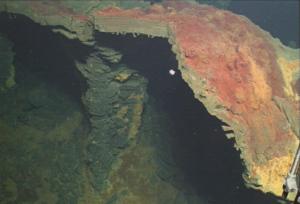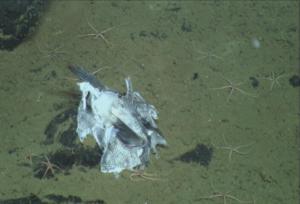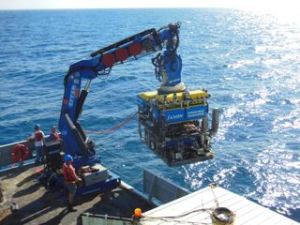Preliminary results from our cruise
As we head back to shore we’ve all been scrambling to pack up our gear, copy video dvds from the Jason cameras, catch up on sleep, and look at the data that we’ve collected (not necessarily in that order!). The weather is deteriorating as we head east and the swell is getting larger. It’s getting harder to walk around—impossible to walk in a straight line and making dart throwing extra dangerous. They’ve rolled out the anti-slip mats in the galley to keep our plates from sliding around. It’s a perfect time to post about some of our results so far.
During the cruise we redeployed three BPRs, replacing one that was buried by the 2011 lava flow and exchanging the other two. We installed six new benchmarks total—two to replace benchmarks that were buried by the 2011 eruption and four to expand our coverage and tie our network to the OOI cabled observatory nodes that will be coming on line soon. We then made ROV-based campaign-style pressure measurements on our array of seafloor benchmarks. The preliminary results from our combined BPR instruments and ROV-based pressure survey show somewhat surprising and unexpected behavior from the volcano over the past two years.
1.) The post-2011 eruption inflation rate is higher than we expected to see. We measured about 1.22 m of uplift since August 2011, totaling 1.57 m of reinflation since the April 2011 eruption, which is an average rate of 61 cm/yr. For comparison, during most of the period between the 1998 and 2011 eruptions, we saw steady inflation at only 15 cm/yr.
2.) In addition, we expected to see a gradually decreasing rate of uplift since 2011. Instead, there was an almost a doubling in the inflation rate in September 2012, recorded on both of the BPRs that were in place during 2011-2013.
3.) Overall, this means that Axial has already recovered 65% of the -2.4 m of deflation that we measured during the 2011 eruption. If this inflation rate continues, it will be back to its pre-2011 level of inflation within only another year and a half (by January 2015).
We aren’t prepared to speculate on what this means, but it is clear that the volcano is in a very active phase right now! Once we’re back on shore we can begin to build models to understand our observations. We will be making a stop in Victoria, Canada tomorrow to let some of the science party off the ship to board a different research vessel and head back out to Axial for another two weeks. This gives us an opportunity to walk on solid ground and explore the city for an afternoon. Tomorrow night we will leave Victoria and head to Seattle. It has been a great trip!



















